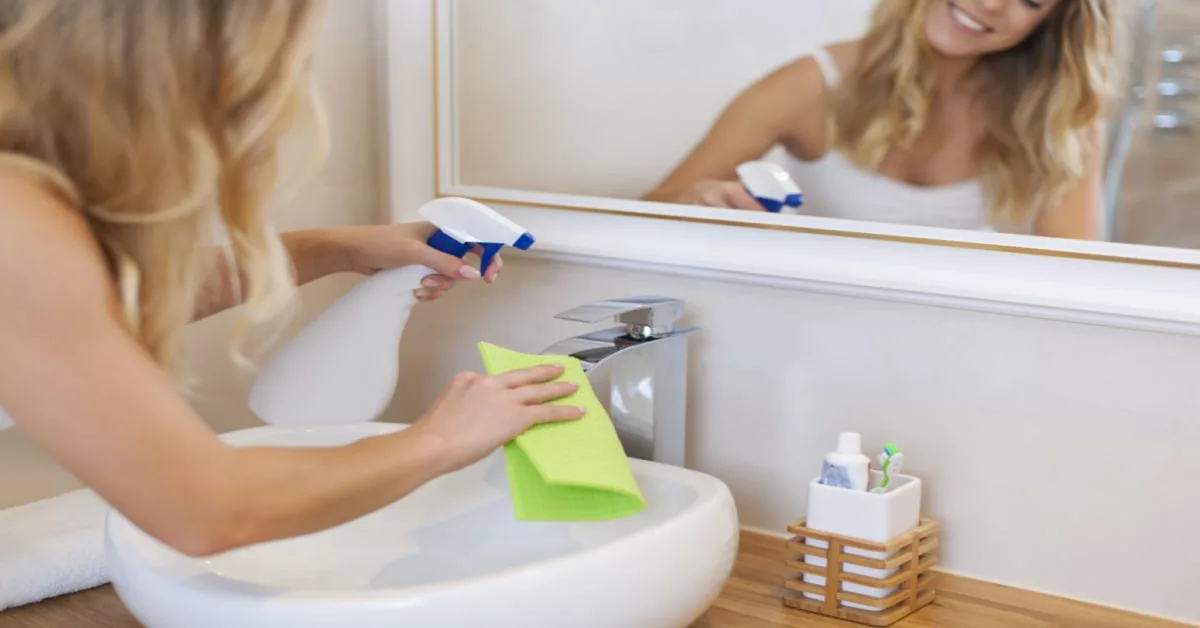Bathroom sink cleaning are necessary for hygiene and appearance. To remove dirt, clean faucets and knobs with a moist towel. Wipe the sink after use and thoroughly clean it regularly. This blog will cover how to clean the bathroom sink properly and what you need to do.

Things we covered for you
What will You Need for Bathroom Sink Cleaning?
Keeping your bathroom sink clean is crucial to household hygiene. Regular cleaning is required to remove soap scum, toothpaste residue, mineral deposits, and other filth from sinks. Cleaning your bathroom sink and keeping it gleaming requires the appropriate materials.
Read: A Guide on How to Clean Kitchen Sink Effortlessly
Get everything you need before cleaning. You require the below things to clean the bathroom sink:
- Rubber Gloves: Wear rubber gloves first. These protect the skin from harsh cleaning chemicals and prevent allergic responses. Plus, they block restroom germs and bacteria.
- Use soft, non-abrasive cleaning cloths or sponges to prevent sink surface scratches. Microfiber towels are soft yet powerful in capturing dirt and grime. Steel wool and abrasive sponges may harm sink materials.
- Choose a high-quality bathroom sink cleaner to dissolve soap scum, remove mineral deposits, and kill bacteria and germs. Find safe sink cleaners for porcelain, ceramic, stainless steel, marble, or other materials.
- Use an old toothbrush to clean hard-to-reach spots around the faucet, knobs, and drain. The tiny bristles remove dirt and grime in cracks and corners for easy removal. Keep a toothbrush for cleaning and replace it as required.
- Baking Soda (Optional): This natural, soft abrasive may remove stains and filth from your sink without scratching. It removes difficult buildup and smells well. Apply a baking soda-water mixture to tough stains and let it settle for a few minutes before cleaning.
- White vinegar (optional) for a multipurpose, eco-friendly cleaning solution that dissolves mineral deposits, soap scum, and hard water stains. Mix equal parts white vinegar and water in a spray bottle for excellent DIY cleaning. Use a vinegar-soaked rag or sponge to clean the sink.
- Fill a bucket or basin with warm water to rinse cleaning cloths or sponges throughout the cleaning procedure. This keeps you from racing to the sink and provides clean water for rinsing.
- Dispose of waste, cleaning cloths, and packaging in a nearby trash bag. Having a garbage bag keeps your desk orderly and streamlines cleanup.
- To avoid eye discomfort or damage, use protective eyewear with powerful chemical cleansers or work in tight spaces with splashing. Safety goggles or side-shielded spectacles protect.
- Ventilation: Open windows or use exhaust fans for sufficient bathroom ventilation. This circulates air and dissipates cleaning product odours, making cleaning healthier.
- To remove fingerprints and stains from sinks with mirrors or glass components, use a glass cleaner (if applicable). For sparkle, use a streak-free product.
- Consider using a soft-bristled brush to gently scour broad areas, particularly on textured surfaces or elaborate sink patterns, in addition to an old toothbrush.
- Mild dish soap is a good alternative for milder cleaning or removing grease or oil-based stains. Use a tiny quantity of dish soap diluted in warm water to clean the sink before rinsing.
- Optional: Use a squeegee to swiftly remove surplus water and avoid water marks on glass or mirror surfaces. Use it after rinsing to prevent streaks.
- Dry the sink surface with a lint-free towel after cleaning. This keeps water stains away and leaves a clean finish.
- Consider using disinfectant wipes for fast touch-ups and cleaning high-touch surfaces like faucet handles and knobs (19). For extra security, use wipes that kill germs and viruses.
- Consider keeping a package of disposable gloves on hand for convenience and cleanliness during cleaning operations (20). Disposable gloves are handy for filthy or germy surfaces.
- Set a timer to keep on track and fully clean your sink. Depending on filth and accumulation, aim for 10-15 minutes for a rapid clean or 30-60 minutes for a deep clean.
- Enjoy cleaning with background music or your favourite podcast. Choose something uplifting to keep you motivated while working.
- For delicate surfaces like acrylic wash basins, opt for a gentle cleanser and microfiber cloth to avoid scratching.
Having these materials on hand lets you clean your bathroom sink properly. Always read and obey cleaning product labels and test new cleaners on a tiny, inconspicuous sink area before using them more widely. Your bathroom sink may seem clean, fresh, and welcoming with the correct equipment and procedures.
Read: The Top-Grade Office Cleaning Services in Hyderabad
Steps to Clean Gunk Out of Bathroom Sink Drain
Step 1: Prepare the Sink: The unpleasant black gunk in the bathroom sink drain is probably a buildup of hair, soap scum, and bacteria. Firstly, rinse the sink with warm water. This softens surface debris and makes cleaning simpler. Spray or apply cleaner to the sink surface, including the basin, faucet, handles, and drain. Remove soap scum, mineral deposits, and other buildup using a bathroom cleanser. You may also make a cleaning solution with equal water and vinegar to remove difficult dirt. After wiping down the faucet and basin, for tougher clogs, you can try unclogging the drain in your bathroom sink with a baking soda and vinegar solution. And this is the best way to unclog a bathroom drain.
Step-2: Scrub the Sink: Thoroughly scrub the surface with a soft cloth or sponge. Watch for stains, soap scum, and buildup. Use an old toothbrush to clean hard-to-reach faucet, handle, and drain areas. If tough stains persist, add extra cleaning and let it settle for a few minutes before scrubbing. Rinse the sink with warm water to eliminate cleaner residue and filth after scrubbing. Rinse using a bucket or basin of clean water, emptying and refilling it as required.
Step-4: Dry the sink surface thoroughly with a clean cloth or paper towel. Water stains are prevented, and the sink looks glossy and clean. Pay careful attention to the faucet and handle places where water may accumulate and spot.
Step-5: Optional Deep Cleaning: Use baking soda as a mild abrasive cleanser for harder stains or buildup. Sprinkle baking soda over soiled sink surfaces and clean with a moist sponge or towel. Baking soda cleans sinks without scratching. Mix baking soda and water to make a paste and apply it to soiled areas. Let it settle for a few minutes before washing and rinsing.
Step-6: Cleaning Fixtures: Ensure the faucet, knobs, and other fixtures surrounding the sink are clean. Wipe these surfaces with a soft cloth or sponge moistened with cleanser to remove fingerprints, watermarks, and dirt.
Step-7: Dispose of Waste: Place garbage and cleaning items in a trash bag to maintain cleanliness.
Wash the surface with a moist cloth after each use to maintain a clean bathroom sink and avoid accumulation. To eliminate filth and preserve cleanliness, thoroughly clean the sink weekly. After washing the sink, check the surrounding area for any lingering dirt or grime. Wipe off counters, backsplashes, and other surfaces to maintain a clean look. While tempting to use a chemical drain cleaner to unclog a toilet, a safer option might be a plunger or a natural method like baking soda and vinegar. Reflect on your clean bathroom sink! Enjoy keeping your home clean for yourself, your family, and visitors.
Follow these tips and regularly clean your bathroom sink to keep it appealing for years. Adjust your cleaning frequency and methods depending on sink usage and accumulation, and try various products and procedures to discover what works best. While Birch cleaners sinks are known for durability, regular cleaning is still recommended to maintain a hygienic environment. With time and effort, you may clean your bathroom sink to improve its appearance and cleanliness.
Step-8: Reinstall objects: After cleaning and drying the sink, reinstall any previously removed objects, such as soap dishes or toothbrush holders.
Wash the surface with a moist cloth after each use to maintain a clean bathroom sink and avoid accumulation. To eliminate filth and preserve cleanliness, thoroughly clean the sink weekly. After washing the sink, check the surrounding area for any lingering dirt or grime. Wipe off counters, backsplashes, and other surfaces to maintain a clean look. Reflect on your clean bathroom sink! Enjoy keeping your home clean for yourself, your family, and visitors.
Follow these tips and regularly clean your bathroom sink to keep it appealing for years. Adjust your cleaning frequency and methods depending on sink usage and accumulation, and try various products and procedures to discover what works best. With time and effort, you may clean your bathroom sink to improve its appearance and cleanliness.
How to Keep Your Bathroom Sink Clean?
Keeping your bathroom sink clean is crucial to household hygiene. Regularly clean gunk out of bathroom sink drain to remove soap scum, toothpaste residue, mineral deposits, and other filth from sinks. Your bathroom sink may be cleaned thoroughly and gleaming by adopting a systematic strategy and utilising the correct methods.
Bathroom sink cleaning is easy with the appropriate tools and methods. You may clean dirt, grime, and stains using rubber gloves, soft cleaning cloths, an all-purpose cleanser, an old toothbrush, and optional baking soda and white vinegar. Use protective eyewear and ventilation while using powerful cleansers.
When cleaning, pay attention to hard-to-reach places like the faucet, handles, and drain. Wiping down the sink after each use and thorough cleaning weekly prevents accumulation and keeps it clean. Replace things removed while cleaning and appropriately dispose of rubbish. These methods keep your bathroom sink clean and appealing to friends and family. Get your materials, and make your bathroom sink a clean, comfortable centrepiece.
NoBroker Bathroom Cleaning Service to Your Rescue
A thorough cleaning of your house is required occasionally. For a fresh and germ-free basin, follow these steps on how to clean a bathroom sink. In no time, you’ll be enjoying a clean and hygienic bathroom. Nonetheless, most people need more daily time to maintain and clean their homes. You might need domestic help to take care of your housekeeping needs. However, avoid using domestic help’s everyday cleaning services if you want a complete cleaning. You can be confident that your house will be expertly cleaned, with the best outcomes at the most competitive rates, when you work with NoBroker’s professional house cleaning service.
Even after the inspection, we provide you total flexibility to reschedule the cleaning service. You are free to determine how long the cleaning will take and schedule its completion around your schedule. Contact us now to schedule!
Frequently Asked Questions
To avoid blockage, you should clean it with Vinegar and run it under warm water. Make sure to soak the drain stopper in water to clean thoroughly. At least once a week, clean the sink and drain stoppers to eliminate dirt and preserve hygiene. However, apparent stains or smells may need more regular cleaning.
Yes, baking soda is a natural and effective way to clear minor bathtub drain clogs. It works by creating a fizzing reaction when combined with vinegar, which can help break down soap scum, hair, and other debris causing the clog.
Bathroom sink drain traps may be difficult to remove, but various techniques exist. Commonly, debris from soap, food, oil, and grease can clog drain pipes and sink traps. You can clean your sink trap using an old toothbrush or old brush to remove the clog.
Bleach kills germs and bacteria, but it’s not usually advised for bathroom sinks. If misused, bleach may discolour or harm marble, granite, and coloured porcelain sinks. It’s essential to dilute bleach according to the manufacturer’s directions and prevent extended sink contact. Use gloves and ventilation during bleaching to avoid irritation and fumes.
Start with natural solutions like baking soda and vinegar or boiling water. If unclogging bathroom sinks naturally doesn’t work, try a plunger specifically designed for sinks. This can dislodge deeper clogs. For stubborn clogs, a drain snake can reach deeper into the pipes to remove the blockage.













